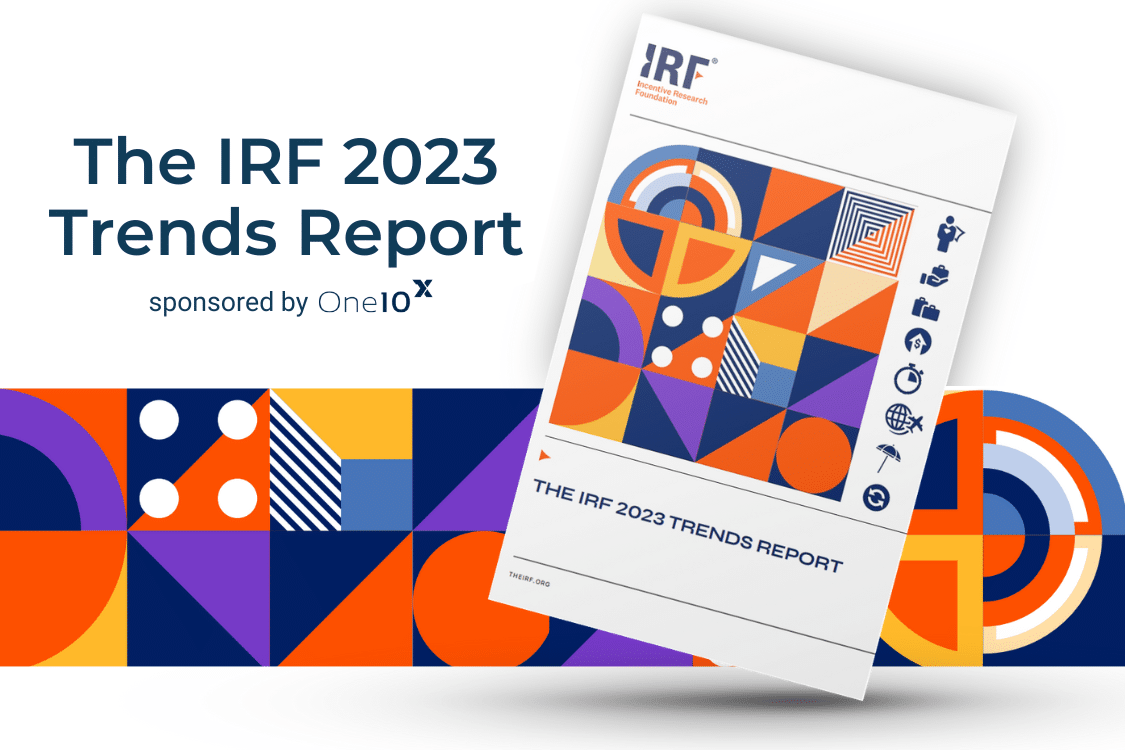With emerging trends such as increased layoffs, hybrid and remote work, and a heightened focus on wellness and mental health, how you engage and motivate team members is becoming quite complex. Incentives are an increasingly critical business strategy to help organizations attract, retain, and build culture across in-office and remote workers, as well as strengthen channel partnerships.
The Incentive Research Foundation 2023 Top Trends Report dives into key trends to be aware of – our One10 Experts recap a few of the trends and share their take on what this may mean for organizations.
IRF Trend #1: Expanded Role of Incentives Professionals
As the report put it, “the new decentralized workforce comes with new expectations, new drivers of performance, and new considerations for the structure and delivery of engagement programs.” Incentive programs must do double-duty as a solution for both retention and attraction, and that goes far beyond gifts. Rewards now need to show concern for employee well-being, recognition (which ties to value), and experiences that connect and engage. The link between culture and incentives has never been stronger.
One10 take: We see that, too. In fact, we’ve been talking about the multi-functional role incentives play in building and sustaining culture for years. For example, even though work is now a mix of hybrid and remote, leaders can integrate incentives into their strategy to create a connected culture. And while the nature of incentives changes over time (for example the strong emphasis on sustainability mentioned in the report), their role in employee retention continues to grow.
The report also mentions employee well-being as a key area of focus. We definitely see that reflected in wellness merchandise, one of the most requested products as part of our Rewarding You program.
IRF Trend #2: Scaling Back and Ramping Up
This is an interesting “push/pull” trend. On one side you have less hotel inventory, fewer hospitality staff, and higher costs – all of which are a barrier to incentive travel. But on the other hand, the report sees strong incentive travel programs, with 56% of buyers increasing per person spending compared to 2019. Experience is ‘the new luxury’ as the report says, because unique, memorable experiences are at a premium. (And while they see most travel preferences for US travel buyers staying close to home, Western Europe ranks as the 5th most popular location, looking ahead, and “the top choice for buyers from the rest of the world.”)
One10 take: Especially after two years of being stuck in one place (for many) and the natural appeal of travel, it makes sense that organizations want to reward employees with this kind of incentive. Travel has a built-in appeal: it’s an experience your employees can’t create on their own, from over-the-top destinations to exclusive accommodations and experiences that immerse your employees in another culture. Successful incentive travel programs are designed around once-in-a-lifetime moments. And that translates into feeling valued.
IRF Trend #3: Inflation Increases Perceived Value of Non-Cash Rewards
Inflation is so often in the news lately that the perception of it is there, regardless of the actual day-to-day situation. With higher costs, or fears of costs going up, people perceive non-cash rewards to be more, well, rewarding.
One10 take: We’ve long said cash is not king when it comes to incentives. Points programs have multiple benefits, from showing appreciation, to allowing employees to choose (versus everyone getting a mug), to not being spent right away on everyday necessities (even more likely to happen when inflation is higher, in reality or perception). For HR professionals or those managing incentive programs, using a points programs allows for budget flexibility by adjusting redemption levels. The proverbial “win-win”!
IRF Trend #4: Patience Has Run Out
This is an intriguing one, clearly more attitudinal. The report found that suppliers who used to be accepting of Covid-related issues are “losing their patience.” Now, supply chain issues and staffing shortages are not issues that those in the industry want to hear, especially as costs increase. This puts pressure on incentive travel planners as well as on industry responses to RFPs as you factor in compressed schedules, increased demand and flat or decreased budgets.
One10 take: We always advocate for putting yourself in someone else’s shoes. Knowing our partners are under pressure just means we have to be more prepared and always have a plan B. Fortunately, being in business for more than 80 years means we have plenty of experience to pivot as needed. Our expertise in travel and events, incentives and recognition, and training communications and analytics drives better performance for our clients.
For more key takeaways and top incentive trends, check out the full IRF 2023 Top Trends Report.


